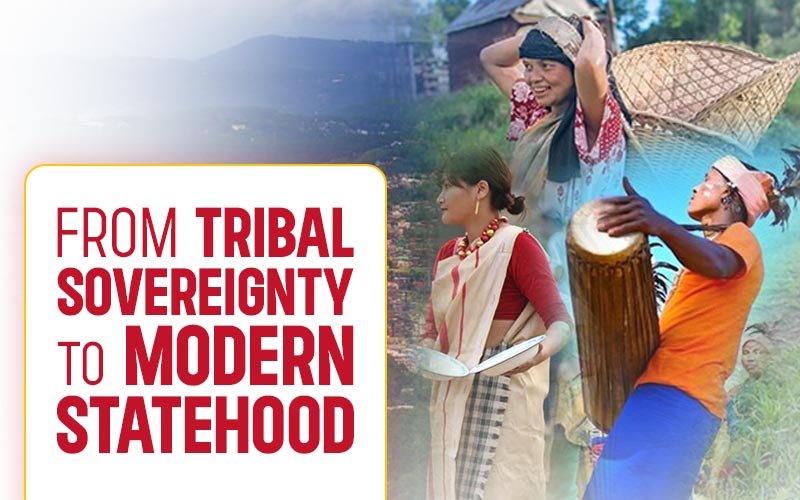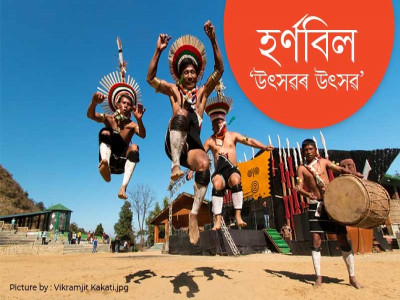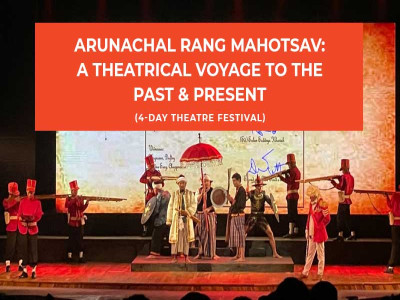
From Tribal Sovereignty to Modern Statehood
Meghalaya, meaning the "Abode of Clouds," is
known for its rich culture, breathtaking landscapes, and vibrant traditions.
Its fascinating history is shaped by its indigenous tribes, colonial
encounters, and the struggle for self-determination.
Ancient and Medieval Era
Meghalaya has been home to three major tribes: Khasi,
Jaintia, and Garo, each with distinct traditions, customs, and governance
systems. These tribes are believed to have migrated from the Tibeto-Burman and
Mon-Khmer regions.
The Khasi practiced a unique matrilineal system where
lineage and inheritance were traced through women. Their governance revolved
around independent chieftainships or Himas, led by a Syiem (chief) with
councils of elders.
Before the arrival of Christianity, the tribes practiced
animism, worshiping nature and ancestral spirits. They revered the sacred
forests, mountains, and rivers, believing them to be the dwelling places of
deities. Ceremonial offerings and festivals, such as Shad Suk Mynsiem and
Wangala, were central to their spiritual lives.
Early Encounters with the British
The British arrived in the 19th century, drawn by the
region’s strategic location and natural resources. This marked the beginning of
significant socio-political changes in Meghalaya.
●
Khasi Hills: The British
annexed the Khasi Hills following the Anglo-Khasi War (1829–1833).
●
Jaintia Hills: The Jaintia
Kingdom was annexed in 1835 after fierce resistance.
●
Garo Hills: The Garo tribes
came under British control in the 1870s.
Despite colonial rule, the tribes fiercely resisted
British dominance, striving to maintain their autonomy and cultural identity.
Resistance Leaders
U Tirot Sing Syiem (1802–1835), the Khasi leader of
Nongkhlaw, is a revered figure in Meghalaya’s history for his staunch
opposition to British colonial expansion. When the British proposed
constructing a road through Khasi territory, U Tirot Sing recognized the threat
to his people's sovereignty and resisted. Despite attempts at negotiation, the
British persisted, prompting him to lead a guerilla resistance during the
Anglo-Khasi War (1829–1833). For years, his efforts disrupted British
operations and showcased his strategic leadership. However, he was eventually
captured in 1833 and imprisoned in Dhaka (now Bangladesh), where he died in
1835. U Tirot Sing remains a symbol of defiance and is celebrated as one of
Meghalaya’s foremost freedom fighters.
Supporting his efforts was Ka Phan Nonglait, a courageous
Khasi woman who played a pivotal role during the Anglo-Khasi War. She spied on
British forces and provided critical intelligence to U Tirot Sing, ensuring the
success of several resistance operations. Her bravery and dedication have
earned her a lasting place in the history of Meghalaya.
Another prominent leader in Meghalaya’s fight against
colonial rule was Pa ToganSangma, a Garo warrior who led an armed revolt
against the British in 1872. Motivated by his unwavering commitment to his
people’s sovereignty, Pa ToganSangma fought valiantly to protect Garo lands and
traditions. Although his resistance was ultimately quelled, his heroism and
sacrifice continue to inspire pride among the Garo people. Together, these
leaders represent the resilience and spirit of Meghalaya’s tribes in their
struggle for autonomy and identity.
Integration with Assam
After India gained independence in 1947, Meghalaya was
incorporated into Assam. However, cultural differences and the desire for
tribal autonomy led to demands for a separate state.
Statehood Movement
In 1970, Meghalaya became an autonomous state under the
Assam Reorganisation Act. On January 21, 1972, it achieved full statehood,
becoming India’s 21st state. This ensured the preservation of the region’s
unique identity and provided a platform for its self-governance.
Transition in Beliefs and Culture
The arrival of Christian missionaries during the British
era significantly influenced the region’s culture and beliefs.
Before Missionaries:
○
Tribes practiced animism,
nature worship, and ancestral veneration. Sacred groves were considered holy,
and rituals were performed to seek blessings for prosperity and protection.
○
Festivals like Wangala
(harvest festival of the Garo tribe) and Shad Suk Mynsiem (Khasi thanksgiving)
were deeply spiritual.
Impact of Missionaries:
○
Missionaries introduced
Christianity, modern education, and healthcare.
○
Shillong emerged as a hub of
educational and cultural exchange, with institutions like St. Edmund’s College
and Don Bosco School becoming prominent.
Despite adopting new faiths, many tribes continue to
preserve their indigenous traditions and festivals, reflecting a harmonious
blend of the old and the new.
Today, Meghalaya is celebrated for its vibrant
traditions, such as the matrilineal system, music and dance, and festivals. The
state’s history of resistance and cultural preservation inspires its continued
development.
Meghalaya’s history is a tapestry of cultural richness,
resistance, and adaptation. From its ancient animistic traditions to its role
in India’s independence narrative, Meghalaya continues to thrive as a state
where tradition and modernity coexist seamlessly.
Disclaimer: The opinions expressed in this article are those of the author's. They do not purport to reflect the opinions or views of The Critical Script or its editor.

Newsletter!!!
Subscribe to our weekly Newsletter and stay tuned.

















Related Comments